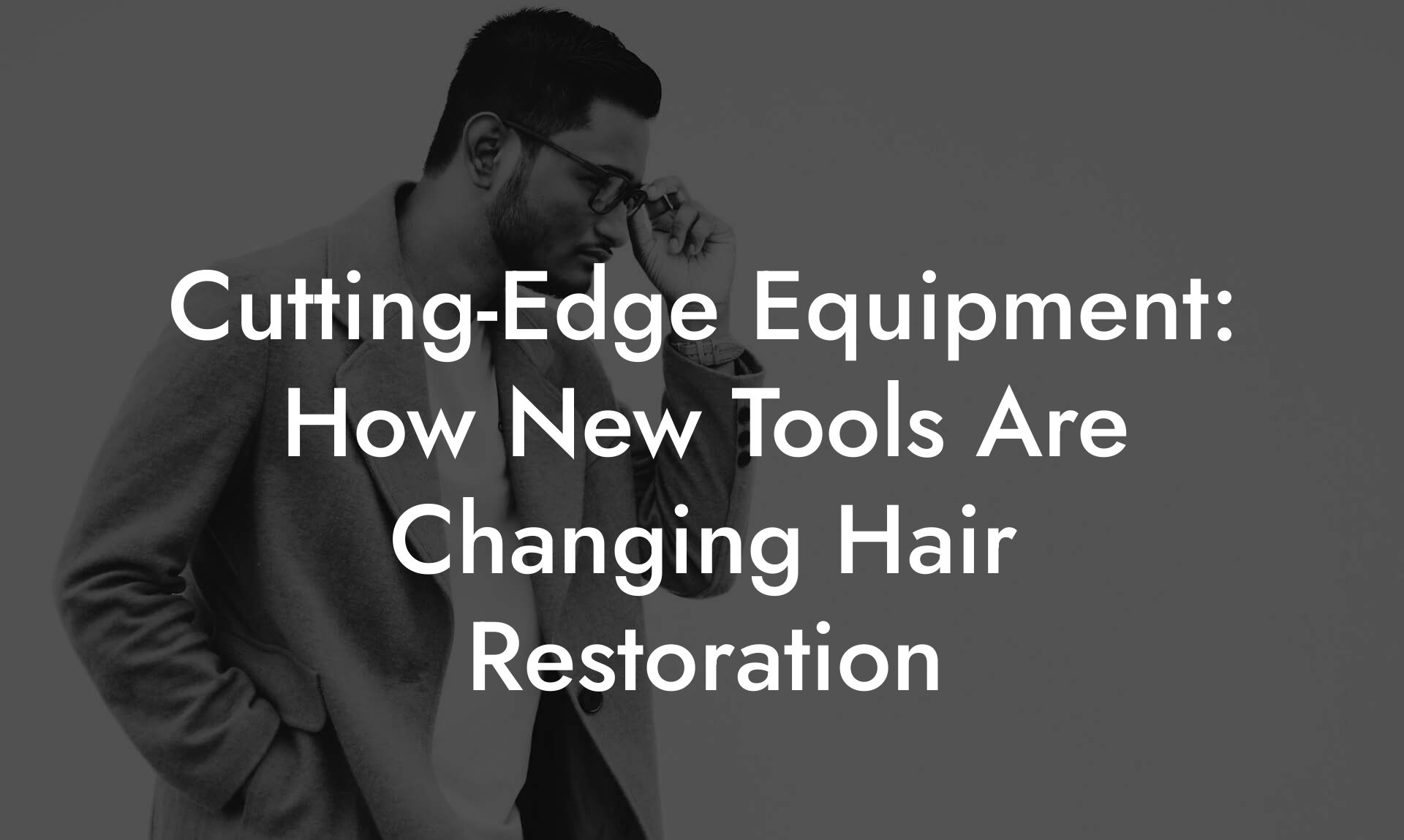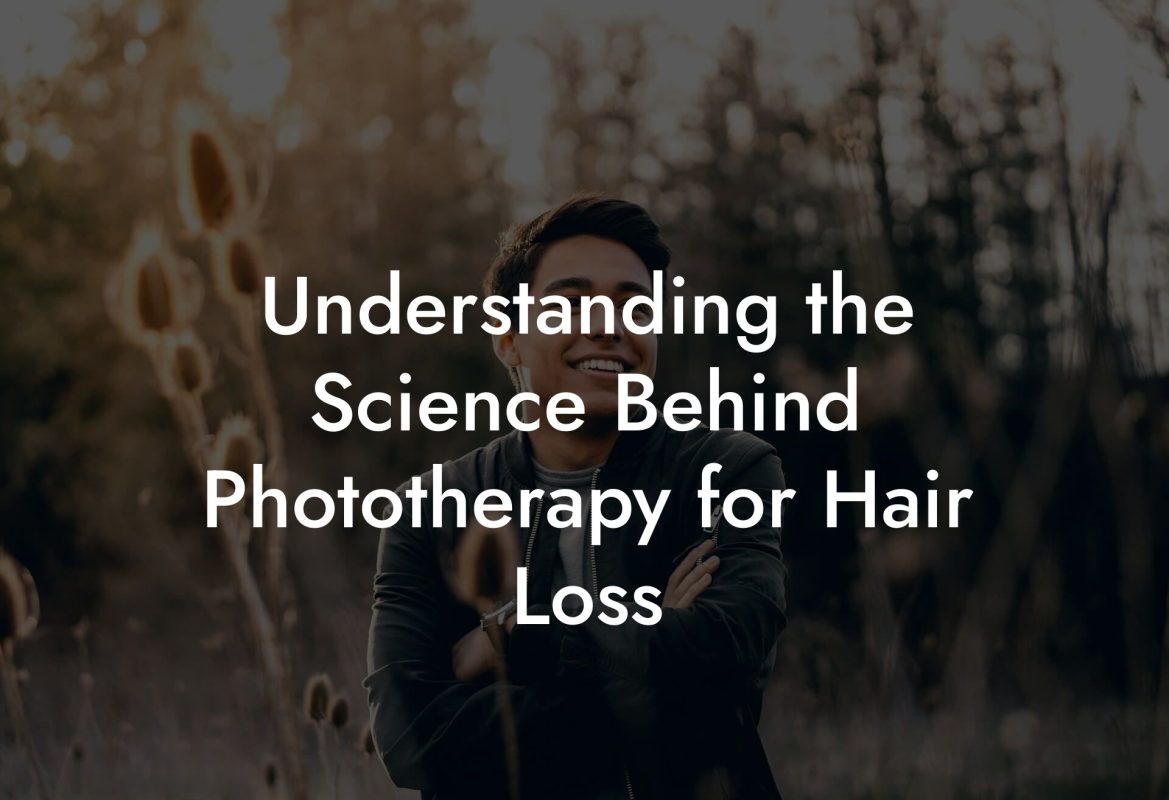Hair Loss Library
Cutting-Edge Equipment: How New Tools Are Changing Hair Restoration

Imagine a world where your receding hairline gets a high-tech makeover, where cutting-edge equipment takes the stage and transforms hair restoration into a futuristic, almost sci-fi experience. Welcome to Mane Matrix’s deep dive into "Cutting-Edge Equipment: How New Tools Are Changing Hair Restoration." Today, we’re exploring the bleeding edge (pun absolutely intended) of hair restoration technology that’s reshaping how modern men tackle hair loss—without breaking the bank or stepping into an awkward doctor’s office.
What is Cutting-Edge Equipment in Hair Restoration?
Gone are the days when you had to rely solely on comb-overs and dodgy hair fibers. Today’s hair restoration scene is booming with innovations that merge technology, science, and a dash of artistry. Cutting-edge equipment in hair restoration refers to advanced tools and devices designed to diagnose, treat, and stimulate hair regrowth with unparalleled precision. Think of everything from AI-powered scalp scanners to robotic hair transplant systems that work with the accuracy of a seasoned barber and the precision of a space-age robot.
At the heart of this revolution is the goal of providing modern men with a tailored, effective solution for hair loss—all without the stigma and expense of traditional consultations. These new tools not only make professional assessments more accessible but also inject an element of geek-cool into the world of hair restoration, making it easier than ever for millennials and Gen Z to reclaim their confidence and style.
A Journey Through the Evolution of Hair Restoration Tools
The evolution of hair restoration has been nothing short of remarkable. From the humble beginnings of primitive remedies and over-the-counter shampoos to today’s high-tech interventions, the journey has been one of innovation and reinvention. We’ve swapped out clunky, outdated methods for streamlined, digital solutions that combine data analytics, laser precision, and hands-on artistry.
Our predecessors once depended on vaguely effective potions and anecdotal advice. Now, after years of meticulous R&D and technological breakthroughs, hair restoration treatments use sophisticated equipment capable of mapping out your scalp like a topographical chart. With tools that harness the power of artificial intelligence and robotics, today’s hair restoration isn’t just about aesthetics—it’s about using science to empower your hair’s natural journey.
Whether you’re sporting a stylish fade or a rugged, natural look, the latest equipment offers personalized insights that tell you what’s really going on beneath the surface. This level of customization means you’re not just buying a treatment; you’re investing in a tailored roadmap to reclaim your mane.
Revolutionizing Hair Restoration: The Innovative Equipment Taking Center Stage
Let’s talk tech! The new toolkit for hair restoration encompasses everything from smart diagnostics to futuristic transplant machinery. Here’s a closer look at the standout equipment revolutionizing the industry:
AI-Powered Scalp Diagnostics
Imagine having a mini supercomputer analyze your scalp in real-time. AI-powered scalp diagnostics use high-resolution imaging and machine learning algorithms to scan your scalp, detect early signs of hair thinning, and analyze hair density, follicle health, and scalp conditions. This smart gadget then generates a personalized report, giving you a crystal-clear picture of your hair health.
No more guesswork or embarrassing self-assessments in poorly lit rooms. With a quick, non-invasive scan, these tools offer recommendations tailored just for you. Advanced software identifies patterns that even seasoned professionals might miss, translating complex data into actionable insights. This is precision at its finest—a diagnostic procedure that’s as high-tech as it is user-friendly.
Robotic Hair Transplant Systems
Say hello to the era of robotic hair restoration, where artificial intelligence meets surgical precision. Robotic hair transplant systems offer highly detailed extraction and implantation processes with minimal invasiveness and maximum efficiency. These systems account for factors like donor hair quality, optimal implantation angles, and natural hairline aesthetics.
The technology doesn’t just speed up the process; it enhances overall accuracy. With a level of precision that reduces human error, these robots can maximize hair density while ensuring minimal trauma to the donor and recipient areas. For the modern man, this means less downtime, fewer complications, and results that look naturally amazing.
Low-Level Laser Therapy (LLLT) Devices
Low-Level Laser Therapy isn’t just for the gym or your local spa—today, portable devices are making waves in hair restoration. These devices use specific wavelengths of laser light to stimulate blood flow and encourage cellular activity in the scalp. The result? Enhanced hair thickness, improved follicle health, and a notable boost in hair regrowth for many.
With easy-to-use, at-home LLLT devices, you can now administer precise laser treatments in the comfort of your own bathroom. They are non-invasive, painless, and a fun way to feel like you’re giving your hair a workout session. Who knew laser hair therapy could be so futuristic yet so accessible?
Advanced Imaging and 3D Digital Scalp Mapping
Imagine a 3D map of your scalp that highlights every follicle and track of blood flow. Advanced imaging techniques and digital scalp mapping provide detailed, real-time visualizations to assist in accurate diagnosis and treatment planning. This technology is the secret sauce behind many modern hair restoration procedures, as it offers an in-depth look at what’s really happening beneath your skin.
By using high-resolution cameras and 3D reconstruction software, practitioners can zoom in on every detail of your scalp, identify problematic areas, and formulate a strategic treatment plan. This not only enhances the accuracy of hair transplant procedures but also ensures that follow-up treatments target the right areas. It’s like having a personalized blueprint for your hair’s comeback.
3D Printing in Hair Restoration
While it might sound like something out of a futuristic movie, 3D printing is beginning to make its mark in hair restoration. This technology is used to create custom-designed surgical guides and models that enhance the precision of hair transplant procedures. By printing out detailed models of your scalp and hairline, surgeons can plan their approach with unparalleled clarity.
3D printing streamlines the entire process, from pre-surgical planning to the actual procedure, ensuring optimal outcomes. It also provides an excellent visualization tool for patients, giving you a sneak peek into the potential results of your treatment.
The Benefits of High-Tech Tools in Hair Restoration
Integrating cutting-edge technology into hair restoration offers a multitude of benefits that go far beyond mere aesthetics. Here are some of the major upsides of modern hair restoration equipment:
- Precision and Personalization: With detailed diagnostic tools and robotic systems, treatments are highly customized to the individual’s unique hair and scalp profile.
- Minimally Invasive Procedures: Advanced equipment like robotic systems and LLLT ensure that procedures are less invasive, leading to quicker recovery times and fewer complications.
- Enhanced Safety and Accuracy: High-resolution imaging and digital mapping reduce the risk of errors, ensuring that treatments are administered with top-notch accuracy.
- Cost-Effective in the Long Run: While the initial cost of high-tech equipment may be steep, the reduction in complications and faster recovery times can translate to overall cost savings.
- Empowering Patient Education: Detailed diagnostic reports and visualizations provide you with a clear understanding of your hair health, allowing you to be an active participant in your treatment plan.
- Futuristic Aesthetics: The blend of modern technology with aesthetic procedures ensures that results look natural and feel truly personalized.
These benefits are particularly appealing to a tech-savvy, modern audience that values efficiency, accuracy, and a holistic approach to personal care. Not only do these innovations make the hair restoration process more effective, but they also enhance the overall experience, making it enjoyable rather than intimidating.
How to Choose the Right Hair Restoration Technology for You
With a plethora of high-tech options at your fingertips, choosing the right hair restoration method can feel like navigating a futuristic maze. Here are some steps to help you decide which technology or combination of them might be best suited for your needs:
1. Get a Professional Consultation
Even though mane recovery has become more accessible, starting with a professional consultation is key. Thanks to tools like AI-powered diagnostics, many clinics offer virtual assessments that allow you to understand your unique hair profile from the comfort of your home.
2. Understand Your Hair Loss Pattern
It’s important to know whether your hair loss is diffuse or concentrated in certain areas, as this can determine the best treatment approach. Advanced scalp mapping tools can visualize exactly where you need help, guiding your treatment strategy.
3. Evaluate the Equipment Options
Explore the available technologies—are you more inclined to try low-level laser therapy at home, or does the idea of a robotic hair transplant spark your interest? Compare the pros, cons, recovery times, and overall aesthetics of each method.
4. Consider Your Lifestyle and Budget
Your day-to-day life and financial considerations play a crucial role. While some treatments may require periodic clinic visits, others can be administered at home. Evaluate which option fits best with your schedule and budget, and remember that investing in your hair health is really investing in your confidence.
5. Research Reviews and Success Stories
Look for testimonials, case studies, and peer reviews from men who have undergone similar treatments. Knowing that others have successfully turned their hair restoration journey into a triumph can offer invaluable reassurance and inspiration.
Breaking Down the Science: How It All Works
If you’re the kind of person who loves a peek under the hood, let’s break down the science behind these game-changing technologies. The core principles driving modern hair restoration involve a combination of cellular stimulation, precise diagnostics, and meticulously planned surgical interventions.
AI-powered diagnostics leverage machine learning algorithms that analyze thousands of hair and scalp images. These algorithms detect subtle changes that might indicate early signs of hair loss or poor follicle health long before they become visible to the naked eye.
Robotic hair transplant systems operate using micro-punch devices controlled by algorithms. These devices are designed to extract hair follicles from donor sites with the utmost precision, minimizing damage to surrounding tissues. Once harvested, the follicles are implanted into thinned or bald areas, strategically arranged to mimic natural hair patterns.
Low-level laser therapy devices, on the other hand, work on the principle of photobiomodulation. By exposing the scalp to low-level laser light, these devices enhance cellular metabolism and improve blood circulation at the follicular level. This therapeutic boost aids in stimulating dormant follicles, essentially giving them a nudge to wake up and start growing again.
Lastly, 3D digital scalp mapping and imaging synthesize data from multiple sources to create an ultra-detailed picture of your scalp’s condition. This data not only helps practitioners pinpoint problematic areas but also tracks progress over time, ensuring that each intervention is as effective as possible.
Case Studies: Real Men, Real Success Stories
Sometimes, the most compelling evidence of progress comes from real-life experiences. Let’s dive into a few case studies that highlight how cutting-edge equipment has transformed hair restoration for modern men.
Case Study 1: From Receding to Revolutionary
Meet Ryan—a 32-year-old tech enthusiast who had tried every solution under the sun to combat his thinning hair. After a thorough AI-powered scalp analysis, Ryan opted for a combination of low-level laser therapy at home and a robotic hair transplant procedure for his more stubborn areas. The result? A natural-looking hairline and a revived sense of confidence that now perfectly complements his love for all things tech.
Ryan’s success story underscores how the integration of smart diagnostics and robotic precision can turn what once seemed like a lost cause into a manageable, even uplifting, hair restoration journey.
Case Study 2: The Power of Personalized Technology
Then there’s Marcus, a 27-year-old creative professional whose early hair loss had him skeptical of one-size-fits-all solutions. After receiving a 3D digital scalp mapping, Marcus discovered that his hair loss was concentrated along the crown area, a detail that traditional methods had overlooked. Utilizing a targeted approach that combined wearable LLLT devices and precision hair transplantation guided by robotic systems, Marcus now showcases a fuller head of hair that’s the envy of his peers.
His journey illustrates that with the right technology, every man—even those who think their situation is hopeless—can achieve results that look both natural and enduring.
Case Study 3: Redefining Hair Restoration Through Advanced Imaging
Lastly, consider David—a 40-year-old entrepreneur who was initially intimidated by the prospect of hair restoration. Thanks to an advanced imaging system, David received a detailed analysis of his scalp that revealed hidden potential for regrowth. With this personalized data in hand, he embraced a combined approach of robotic transplantation and supportive low-level laser therapy. Today, David not only sports a rejuvenated hairline but also shares his transformational journey online, inspiring others to take control of their hair health.
These case studies prove that no two journeys are identical. With cutting-edge equipment tailored to your unique needs, hair restoration can be as individual as you are.
Building Your Personalized Hair Restoration Toolkit
With so many technological breakthroughs at your disposal, constructing a personalized hair restoration toolkit might feel like assembling the ultimate gadget collection. Here’s a guide to piecing together a plan that fits your lifestyle, hair loss pattern, and budget.
Step 1: Start with a Comprehensive Scalp Analysis
The foundation of any successful hair restoration journey is understanding your starting point. Utilize AI-powered scalp diagnostics and 3D imaging technologies for a detailed baseline assessment. This step will identify the precise areas that need intervention and help tailor a treatment plan specifically for you.
Step 2: Explore Your Equipment Options
Whether you prefer at-home treatments like LLLT devices or are ready for a more advanced option such as robotic transplantation, research the available tools and choose those that align with your goals. Consult online reviews, video testimonials, and expert analyses available on platforms like Mane Matrix to gather insights directly from other users.
Step 3: Integrate Technology with Lifestyle Changes
Remember, technology is only part of the equation. Complement your high-tech treatments with lifestyle tweaks like improved diet, stress management, and proper hair care routines. Adopting holistic habits will support the technology-driven interventions and improve overall outcomes.
Step 4: Monitor Your Progress
Use digital tools and apps designed for hair tracking, keeping a log of your treatments, progress photos, and any changes in hair density. Regular follow-up assessments with high-resolution imaging will help you track improvements and adjust your plan as needed.
Step 5: Engage with a Community of Like-Minded Men
Finally, don’t underestimate the power of community. Joining forums, support groups, or following expert websites can offer inspiration, advice, and motivational stories. Knowledge sharing among men who have embarked on similar journeys can be the secret ingredient to staying committed.
Resources and Community Support: Your Next Steps
As you consider your next steps towards hair restoration, remember that you’re not alone in this journey. The modern landscape of hair restoration is supported by a wealth of resources—from expert online communities and peer-led support groups to in-depth guides that break down each high-tech procedure.
At Mane Matrix, our mission is to empower modern men with the knowledge and tools they need to take charge of their hair health in a comfortable, relaxed, and jargon-free environment. We offer comprehensive analyses, up-to-date research, and community insights that demystify the world of hair restoration.
Whether you’re just starting your exploration of high-tech hair restoration or you’re ready to dive into advanced procedures, our community is here to support you. Connect with experts, join forums, and tap into the latest industry trends—all designed to give you a hair restoration roadmap that’s as unique as your hairline.
Frequently Asked Questions About Cutting-Edge Hair Restoration Equipment
Let’s address some of the most common questions that modern men have about the high-tech world of hair restoration.
1. What exactly does “cutting-edge equipment” mean in hair restoration?
It refers to advanced diagnostic and treatment tools that utilize the latest technologies—such as AI-powered scalp analysis, robotic transplant systems, laser therapies, and 3D digital imaging—to provide precise, personalized hair restoration solutions.
2. How do AI-powered scalp diagnostics work?
These systems use high-resolution imaging combined with machine learning algorithms to analyze your scalp. They evaluate hair density, follicle health, and scalp conditions, ultimately providing a detailed report that helps tailor your treatment plan.
3. Are robotic hair transplant systems safe?
Yes, robotic systems are designed to enhance precision and reduce human error. They are minimally invasive and have demonstrated high safety and effectiveness in clinical settings.
4. How does low-level laser therapy (LLLT) promote hair regrowth?
LLLT devices use specific wavelengths of laser light to stimulate cellular activity and boost blood flow in the scalp. This promotes healthier follicles, enhancing the regrowth of hair.
5. What benefits do advanced imaging and digital scalp mapping offer?
These tools provide a detailed, 3D visualization of your scalp, allowing practitioners to pinpoint problematic areas and track progress over time. They enable highly targeted treatments that improve overall outcomes.
6. Can I perform any of these treatments at home?
Yes, several high-tech solutions like LLLT devices are designed for home use. However, for more invasive procedures such as robotic hair transplants, professional consultation is recommended.
7. How do I choose which equipment is right for my hair restoration needs?
Start with a comprehensive scalp analysis using AI-powered diagnostics. Then, research the pros and cons of various technologies, keeping in mind your specific hair loss pattern, lifestyle, and budget.
8. Is there scientific evidence to back these technological advancements?
Absolutely. Numerous studies, clinical trials, and real-life case studies support the effectiveness of these advanced tools. They have reshaped hair restoration techniques, making them more reliable and personalized.
9. How soon can I expect results from these treatments?
Results vary depending on the technique used, the severity of hair loss, and your individual response. While some may notice improvements in a few months, others might experience gradual progress over a longer period.
10. Where can I find more information or connect with others undergoing similar treatments?
Websites like Mane Matrix offer expert analyses, comprehensive guides, and community forums where you can learn more and share experiences with like-minded individuals.
Your Journey to a Bold, Tech-Enhanced Hair Future
Embracing cutting-edge hair restoration equipment isn’t just about grabbing the latest gadget; it’s about reclaiming your confidence and redefining what it means to chisel your own narrative. Each piece of technology—from AI-powered scalp scanners to robotic transplant systems—serves as a stepping stone towards a future where hair restoration is smart, personalized, and hassle-free.
As you stand on the threshold of this revolutionary journey, remember that every technological breakthrough is designed to work for you, to ensure that the strategies are as individualized as your unique hairline. Whether you’re meticulously tracking every follicle’s progress with a dedicated app or marveling at the results of a robotic transplant, you’re stepping into an era where hair restoration is both art and science.
The fusion of technology and hair restoration is more than a trend—it’s a testament to what’s possible when innovation meets personal care. By opting for modern, high-tech solutions, you’re not only addressing hair loss; you’re embracing a lifestyle that values precision, efficiency, and style.
Dive into the future of hair restoration with confidence and curiosity. Empower your journey with the tools and knowledge that bring out the best version of yourself, and celebrate every small victory along the way. With every advanced diagnostic scan, every sleek laser session, and every success story shared, you’re one step closer to looking—and feeling—younger, bolder, and ready to take on the world.
If you loved this article... Dive deeper into the world of mens hair loss with our most popular sections. If there is anything you think is missing or anything you would love for us to write about, just give us a shout.
The Best At-Home Laser Devices for Men’s Hair Loss: A Comprehensive Review
Understanding Low-Level Laser Therapy: How It Promotes Hair Regrowth
Innovative Hair Growth Devices: What’s New in the Market?
A Closer Look at Robotic Hair Transplant Technology
The Future of Hair Restoration: Breakthrough Technologies to Watch
Microneedling Tools: How They Work and Which Ones Deliver Results
Scalp Stimulation Equipment: Are They Worth the Investment?
Comparing At-Home vs. In-Clinic Hair Restoration Devices
Tech-Driven Hair Loss: How Apps and Gadgets Can Track Your Progress
Understanding the Science Behind Phototherapy for Hair Loss
How to Use a Derma Roller for Better Hair Growth: A Step-by-Step Guide
Expert Reviews: The Top Hair Growth Devices of the Year
Smart Hair Tools: Integrating Technology with Your Daily Routine
Cutting-Edge Equipment: How New Tools Are Changing Hair Restoration
The Role of AI in Predicting and Treating Hair Loss
User Experiences: Real Stories from At-Home Hair Restoration Device Users
A Tech Enthusiast’s Guide to the Best Hair Growth Gadgets
Innovative Scalp Massagers: Do They Really Boost Hair Growth?
The Pros and Cons of Using Wearable Hair Loss Monitors
How to Set Up an Effective At-Home Hair Restoration Routine with Tech Tools
















